rate limiting processes part 1
1/70
There's no tags or description
Looks like no tags are added yet.
Name | Mastery | Learn | Test | Matching | Spaced |
|---|
No study sessions yet.
71 Terms
1. What is the rate-limiting step in pharmacokinetics?
the rate-limiting step is the slowest step in a series of kinetic processes that determines the overall rate of the complete process.
How does the rate-limiting step affect subsequent steps in the pharmacokinetic process?
The rate-limiting step imposes an upper limit on the rate of all subsequent steps, meaning it determines the overall speed at which the entire process occurs.
Why is the rate-limiting step important in pharmacokinetics?
The rate-limiting step is crucial because it dictates the speed of the entire process, affecting how quickly a drug is absorbed, distributed, metabolized, and excreted.
What happens if the rate-limiting step is modified or altered?
If the rate-limiting step is altered, it can change the overall rate of the pharmacokinetic process, potentially leading to faster or slower drug action and impact on drug effectiveness or side effects.
Can the rate-limiting step change throughout the process?
Yes, depending on the specific kinetic pathway, the rate-limiting step can shift, but one step will always be the slowest and thus become the limiting factor for the process at that moment.
What does Kabs represent in pharmacokinetics?
the rate constant for the absorption of a drug into the bloodstream. It represents the speed at which the drug is absorbed from the site of administration into systemic circulation.
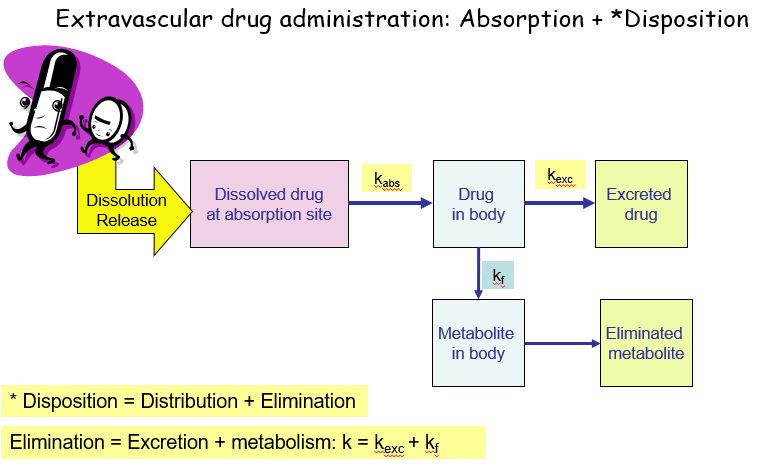
What is K<sub>f</sub> in the context of drug dissolution and absorption?
the rate constant for the dissolution of the drug. It refers to the process by which a solid drug dissolves in a solution, making the drug available for absorption at the site of administration (e.g., in the gastrointestinal tract).
What does Kexc represent in pharmacokinetics?
K<sub>exc</sub> is the rate constant for excretion, which is the process of eliminating the drug from the body, usually through urine, bile, or feces. This is a critical step in the elimination phase of pharmacokinetics.
How are Kabs, Kf, and Kexc related?
These rate constants are all part of the overall disposition of a drug in the body. Disposition includes both distribution and elimination. In this case:
Kabs affects the absorption and entry of the drug into circulation.
Kf governs the dissolution process of the drug to make it available for absorption.
Kexc is related to how quickly the drug is excreted, which is a part of elimination.
Together, Kabs and Kexc can control the overall rate at which a drug is absorbed, distributed, metabolized, and eliminated from the body.
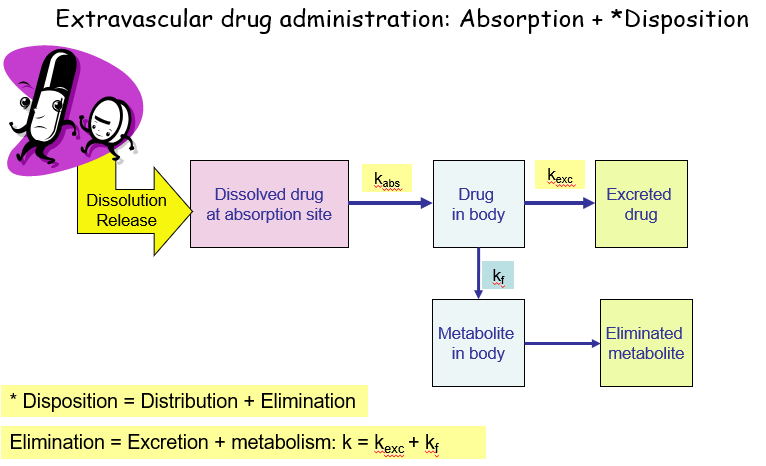
What is meant by "disposition" in pharmacokinetics?
Disposition refers to the processes by which the drug is distributed throughout the body and eliminated (either by excretion or metabolism). It involves how the drug moves through different tissues and organs after being absorbed.
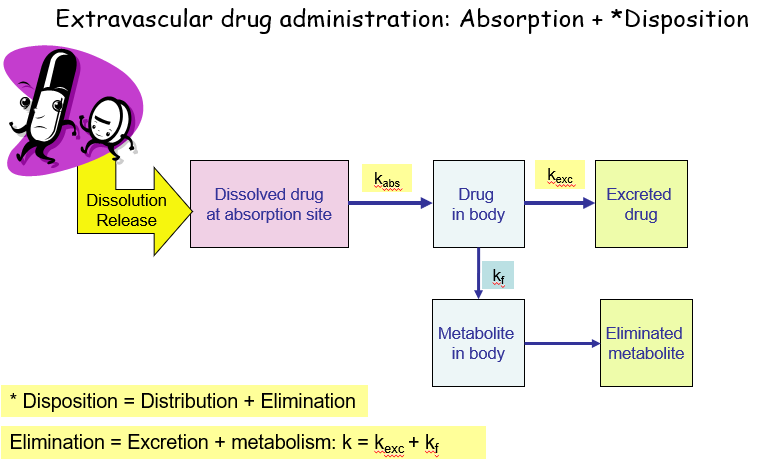
How does the rate of drug absorption (Kabs) and excretion (Kexc) impact drug concentration in the body?
The rate of absorption (Kabs) affects how quickly the drug enters the bloodstream, while the rate of excretion (Kexc) determines how fast the drug is eliminated from the body. A faster absorption and slower excretion lead to higher concentrations of the drug in the body, while a slower absorption or faster excretion may reduce drug concentrations.
How do K<sub>f</sub>, K<sub>abs</sub>, and K<sub>exc</sub> influence the pharmacokinetic profile of a drug?
Together, Kf, K<sub>abs</sub>, and K<sub>exc</sub> influence the overall pharmacokinetic profile, including:
Onset of action: Faster absorption and dissolution (high K<sub>f</sub> and K<sub>abs</sub>) lead to quicker therapeutic effects.
Duration of action: The rate of excretion (K<sub>exc</sub>) affects how long the drug stays in the body and its therapeutic effect.
Bioavailability: The amount of drug available in circulation after absorption depends on both the rate of absorption and the extent of excretion
what is a pro-drug?
A pro-drug is an inactive compound that is metabolized within the body to produce an active drug. Pro-drugs are designed to improve the bioavailability or pharmacokinetic properties of drugs, such as better absorption or longer duration of action.
What happens to a pro-drug following an IV bolus administration?
After an IV bolus of a pro-drug, the pro-drug enters the body and is metabolized into its active form. The active drug then exerts its therapeutic effect.
What is the role of K<sub>f</sub> in the pro-drug’s metabolism?
K<sub>f</sub> is the rate constant for the conversion of the pro-drug into the active drug. It governs the speed at which the drug becomes active after administration.
What is Kexc in relation to the pro-drug and active drug?
Kexc is the rate constant for the excretion of the drug. Once the drug has been metabolized into its active form, it is eventually eliminated from the body, typically through the kidneys or liver. Kexc refers to the elimination of the drug (either the pro-drug or the active drug) from the body.
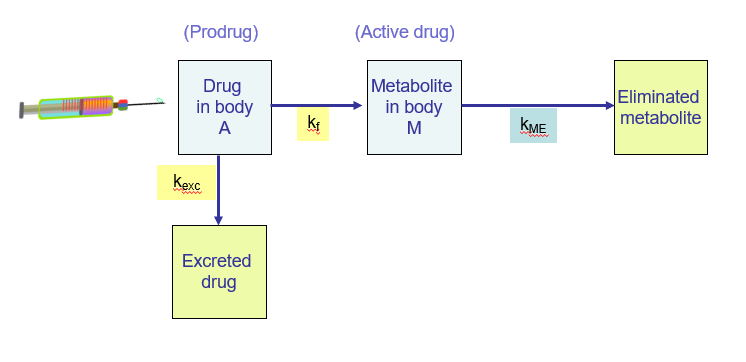
what is disposition?
distribution and elimination
what is elimination?
excretion and metabolism
absorption in the body is done via 2 processes, what are they?
dissolution or release rate limited
permeability rate limited
What happens when a drug has poor solubility in terms of dissolution and absorption?
For drugs with poor solubility, the rate constant for dissolution is smaller than the rate constant for absorption. A slow dissolution process can limit the rate of subsequent steps, making dissolution the rate-limiting step.
: What is the "rate-limiting step" in the case of drugs with poor solubility?
The rate-limiting step occurs when the dissolution process is very slow, limiting the rate of drug absorption and subsequent steps.
What are modified-release formulations?
Modified-release formulations include sustained-release and extended-release drugs that release the drug slowly over an extended period of time.
How does the rate constant for release compare to the rate constant for absorption in modified-release formulations?
In modified-release formulations, the rate constant for release is smaller than the rate constant for absorption, meaning the release process can become the rate-limiting step.
How can we determine if dissolution or release is the rate-limiting step?
We can tell if dissolution or release is the rate-limiting step by observing whether changes in the dissolution rate or release rate lead to faster or slower absorption.
For example, comparing a solid dosage form to a drug in solution or comparing immediate-release versus slow-release formulations.
explain dissolution and release processes as rate limiting steps
drugs with poor solubility:
constant rate of dissolution is less than the rate of absorption.
slow disslution limits rate of other steps.
so dissolution becomes rate limiting.
modified release formulations:
release drug slowly over extended periods of time
constant rate of release less than absorption, slow release becomes rate limiting step.
What happens when a drug has low solubility in terms of its dissolution and absorption?
For drugs with low solubility, the dissolution rate constant is smaller than the absorption rate constant. If the dissolution process is very slow, it can limit the speed of the next steps, making dissolution the rate-limiting step
What does it mean when dissolution becomes the "rate-limiting step"?
When the dissolution process is slow, it restricts how quickly the drug is absorbed and processed by the body, making dissolution the rate-limiting step.
How do the rate constants for release and absorption compare in modified-release formulations?
In modified-release formulations, the rate constant for release is slower than the rate constant for absorption, so the release process may become the rate-limiting step.
How can we identify whether dissolution or release is the rate-limiting step?
We can determine this by observing how changes in dissolution rate or release rate affect absorption speed. For example, comparing a solid dosage form to a drug in solution, or contrasting immediate-release versus slow-release formulations.
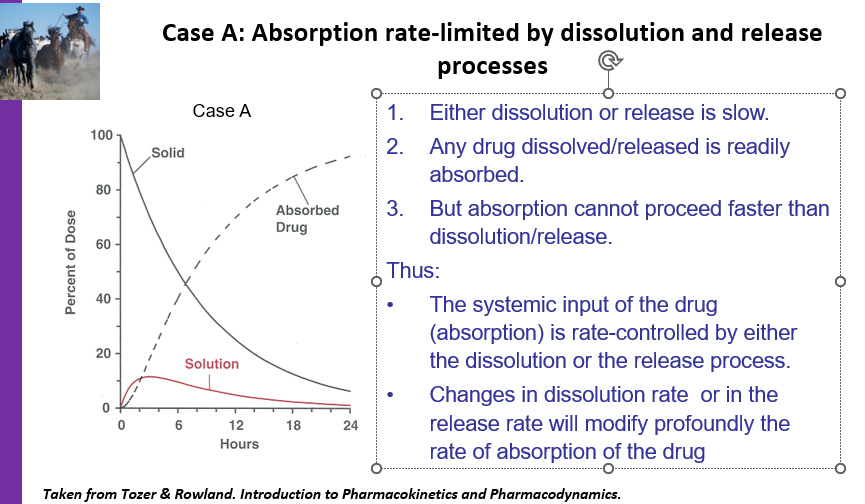
1.Either dissolution or release is slow.
2.Any drug dissolved/released is readily absorbed.
3.But absorption cannot proceed faster than dissolution/release.
Thus:
•The systemic input of the drug (absorption) is rate-controlled by either the dissolution or the release process.
Changes in dissolution rate or in the release rate will modify profoundly the rate of absorption of the drug
How do changes in dissolution or release rate impact absorption?
Any change in the dissolution rate or release rate can significantly affect the rate of drug absorption. Faster dissolution or release leads to faster absorption, while slower rates result in slower absorption.
What happens when dissolution and release are fast, but absorption is limited by permeability?
When dissolution and release are fast, the drug is quickly available in the system, but absorption is limited by poor permeability, meaning the drug cannot be absorbed into the bloodstream efficiently, despite being dissolved.
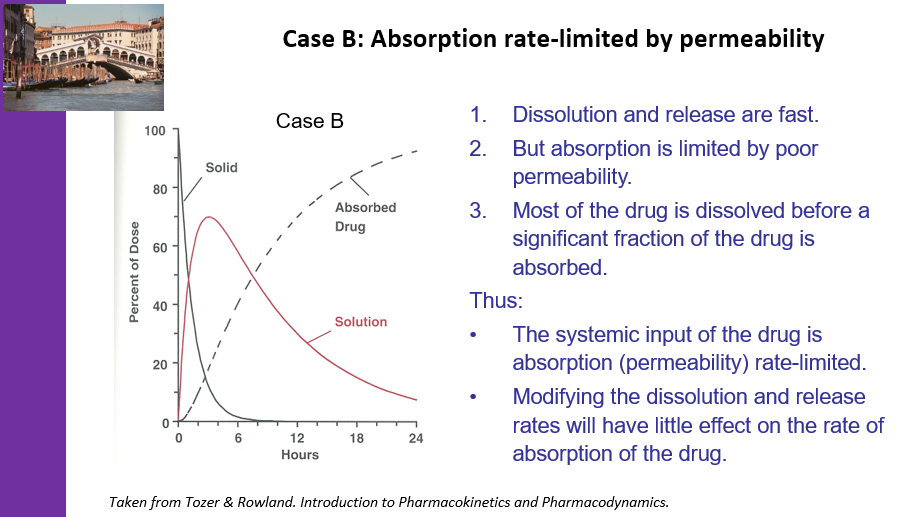
How does permeability affect drug absorption when dissolution and release are fast?
Even if the drug dissolves or is released quickly, poor permeability across biological membranes (like the intestinal wall) limits absorption into the bloodstream. The drug is readily available but is absorbed slowly due to this permeability issue.
What happens to the drug in the body when dissolution and release are fast but absorption is permeability-limited?
A large portion of the drug becomes dissolved and available in the body, but only a small amount is absorbed because of the permeability limitation. Most of the drug is dissolved before a significant amount is absorbed into the bloodstream.
What is the rate-limiting factor for drug absorption when dissolution and release are fast?
In this case, absorption is rate-limited by permeability, meaning the ability of the drug to cross biological membranes is the limiting factor for how quickly the drug enters the bloodstream.
Will changing the dissolution or release rate affect the rate of absorption if absorption is permeability-limited?
No, modifying the dissolution or release rates will have little effect on the rate of absorption because the rate-limiting step is the permeability of the drug across membranes, not how fast it dissolves or is released.
how can we tell when dissolution and release processes are rate limiting?
when increase or decrease in dissolution or release rate leads to faster or slower absorption
What does it mean for drug kinetics to be absorption rate-limited after parenteral administration?
Absorption rate-limited means that the rate at which the drug enters the bloodstream is the slowest step. Despite the drug being injected parenterally, the slow absorption into the bloodstream limits the drug's overall action and speed.
How does absorption rate-limitation affect the drug's action?
When absorption is rate-limited, the drug is available in the bloodstream slowly, which limits how fast it starts working and how quickly it can exert its effects.
What is an example of absorption rate-limitation after parenteral administration?
An example would be a drug injected into a muscle, where the drug takes time to be absorbed into the bloodstream from the muscle, limiting the speed of its action.
What does it mean for drug kinetics to be disposition rate-limited after parenteral administration?
Disposition rate-limited means that after the drug enters the bloodstream, the rate of distribution, metabolism, and elimination of the drug are the slowest steps, controlling the overall drug action and duration in the body.
How does disposition rate-limitation affect the drug's action?
When disposition is rate-limited, even if the drug enters the bloodstream quickly, the speed of distribution, metabolism, and elimination within the body limits how long the drug remains active and how quickly it is cleared from the body.
What is an example of disposition rate-limitation after parenteral administration?
A drug that is injected intravenously may enter the bloodstream quickly, but if it is metabolized or eliminated slowly, the metabolism and elimination processes become the limiting factors for the drug's overall effect.
What does it mean when disposition elimination is the rate-limiting process?
It means that the elimination process (including metabolism and excretion) is the slowest step, which controls how quickly the drug leaves the body, even if absorption is fast.
When is the case of absorption rate-limited versus elimination rate-limited most common?
This is the most frequent case when the absorption rate constant (k<sub>abs</sub>) is greater than the elimination rate constant (k), meaning absorption occurs faster than elimination.
How do the absorption half-life and elimination half-life compare when absorption is faster than elimination?
When absorption is faster than elimination, the absorption half-life (t1/2 abs) is much shorter than the elimination half-life (t1/2). This means absorption happens quickly, but elimination takes longer
What happens when the absorption process is faster than the elimination process?
The drug enters the bloodstream quickly, but the elimination process is slower, meaning the drug stays in the body longer. The elimination rate becomes the key factor controlling the drug's decline in concentration.
How does elimination control the decline of the drug concentration in the terminal phase?
: In the terminal phase, elimination becomes the rate-limiting step, determining how quickly the drug is cleared from the body, which controls how fast the drug concentration declines over time.

What does kabs >> k and t1/2 abs << t1/2 mean in terms of drug kinetics?
It means that the absorption rate constant (kabs) is much faster than the elimination rate constant (k), and the absorption half-life is much shorter than the elimination half-life, indicating that absorption is faster than elimination.
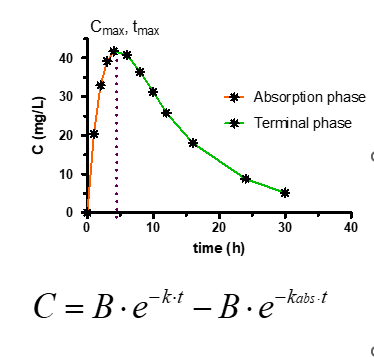
What happens at the peak (tmax, Cmax) in disposition elimination rate-controlled kinetics?
At the peak (t<sub>max</sub>, C<sub>max</sub>), most of the drug has been absorbed into the bloodstream, but little has been eliminated by the body. This is when the drug concentration is at its highest.
What controls the decline of the drug concentration during the terminal phase?
The decline in drug concentration during the terminal phase is primarily controlled by elimination (metabolism and excretion), which dictates how quickly the drug is cleared from the body.
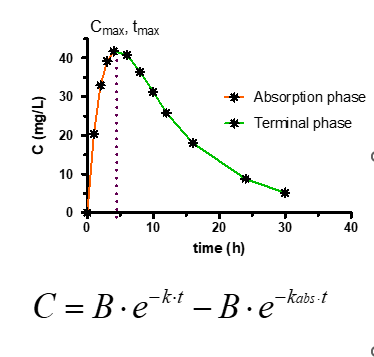
How is the elimination half-life related to the terminal phase?
The elimination half-life (t1/2) measured during the terminal phase corresponds to the elimination rate constant (k), reflecting how quickly the drug is eliminated from the body.
What does it mean when disposition elimination rate is the rate-limiting process?
t means that the elimination process (metabolism and excretion) controls the decline of the drug concentration in the body after absorption, especially during the terminal phase.
How does the elimination process affect the overall drug kinetics after absorption?
After the drug is absorbed and reaches its peak concentration, the elimination process controls how quickly the drug concentration decreases in the body, particularly in the terminal phase.
What does flip-flop kinetics refer to in drug pharmacokinetics?
Flip-flop kinetics occurs when the absorption process is slower than the elimination process. In this case, the absorption rate constant (k<sub>abs</sub>) is smaller than the elimination rate constant (k), meaning absorption is the rate-limiting step.
How does absorption rate-limited kinetics affect drug absorption and elimination?
In absorption rate-limited kinetics, the absorption process is much slower than elimination, meaning the drug takes longer to be absorbed than to be eliminated from the body. This results in a slow absorption rate controlling the overall pharmacokinetics, including the elimination process.
What happens when the absorption half-life (t<sub>1/2 abs</sub>) is much longer than the elimination half-life (t<sub>1/2</sub>)?
When the absorption half-life is much longer than the elimination half-life, the absorption process is much slower than elimination, leading to flip-flop kinetics where absorption becomes the rate-limiting step for the drug's entire pharmacokinetic profile.
What is the effect of slow absorption on the drug's terminal phase in flip-flop kinetics?
In flip-flop kinetics, the terminal phase of the drug’s pharmacokinetic profile is mainly controlled by elimination, but it is delayed because the absorption process is very slow. The drug remains in the body longer due to slow absorption, even though elimination is fast.
Where is most of the drug located during flip-flop kinetics?
During flip-flop kinetics, at any given time, most of the drug will either be at the absorption site (not yet absorbed) or eliminated from the body, as the absorption process is slower than the elimination process.
What controls the drug concentration in the body during flip-flop kinetics?
The absorption process is the rate-limiting step, controlling the overall drug concentration in the body, including its elimination. The slow absorption dictates how quickly the drug is absorbed and how soon it can be eliminated.
What is meant by flip-flop kinetics in pharmacokinetics?
Flip-flop kinetics occurs when the absorption rate constant (k<sub>abs</sub>) is much smaller than the elimination rate constant (k), meaning that the absorption process is slower than elimination.
How does absorption rate-limited kinetics affect the overall drug process?
n absorption rate-limited kinetics, absorption is the rate-limiting step because it occurs slower than elimination. The elimination rate constant (k) is faster, but absorption controls the drug’s absorption and elimination timelines.
What happens when absorption half-life (t<sub>1/2 abs</sub>) is longer than the elimination half-life (t<sub>1/2</sub>)?
When absorption half-life (t<sub>1/2 abs</sub>) is much longer than the elimination half-life (t<sub>1/2</sub>), the absorption process becomes slower than elimination, resulting in flip-flop kinetics, where absorption limits the overall drug kinetics.
How does flip-flop kinetics affect the terminal phase of drug concentration?
In flip-flop kinetics, the terminal phase (when drug concentration decreases) is primarily influenced by elimination, but it is delayed due to the slow absorption process, which controls how the drug reaches its peak and is eliminated.
Where does most of the drug remain during flip-flop kinetics?
During flip-flop kinetics, most of the drug is either still at the absorption site (not yet absorbed) or has already been eliminated from the body, because the absorption process is slower than elimination.
How does the absorption process influence the drug’s overall concentration during flip-flop kinetics?
In flip-flop kinetics, the absorption process is the rate-limiting step, meaning it controls both the drug’s absorption and elimination. The slow absorption delays the drug's elimination, affecting the concentration over time.
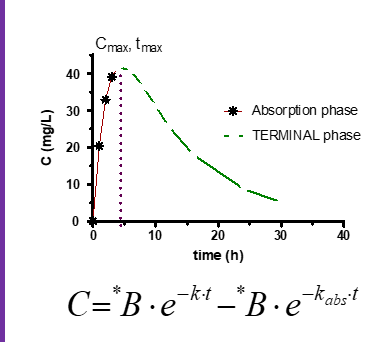
Absorption rate-controlled kinetics (k > kabs)
(“flip-flop” kinetics)
What happens when the drug reaches its peak concentration (t<sub>max</sub>, C<sub>max</sub>) in absorption rate-limited kinetics?
A considerable amount of the drug has not yet been absorbed when the peak concentration (t<sub>max</sub>, C<sub>max</sub>) is reached.
How is the decline of the drug during the terminal phase controlled in absorption rate-limited kinetics?
the decline (elimination) of the drug during the terminal phase is rate-controlled by the absorption process. The drug is eliminated at the same rate it is absorbed.
What does the half-life obtained from the terminal phase correspond to in absorption rate-limited kinetics?
: The half-life obtained from the terminal phase corresponds to the absorption rate constant, also known as the absorption half-life.
YOU MUST BE ABLE TO DO THE FOLLOWING FOR THE EXAM:
1.I can recognize whether the kinetics of a drug are either rate-limited by :
a.Its dissolution / release / absorption
or
b.Its disposition (elimination)
By comparing
•plasma profiles,
and
•the rate constant (or the half-life) of the terminal phase for the extravascular product with the elimination rate constant (or the elimination half-life).
●
2.I can describe the “flip-flop” kinetic profile observed following administration of sustained/extended/prolonged/controlled released dosage forms and explain how the plasma profile can be modified by adjustment of the release/absorption rate constant.
REWATCH THE RECORDING FOR THIS LECTURE TO UNDERSTAND GRAPHS AND TABLES.